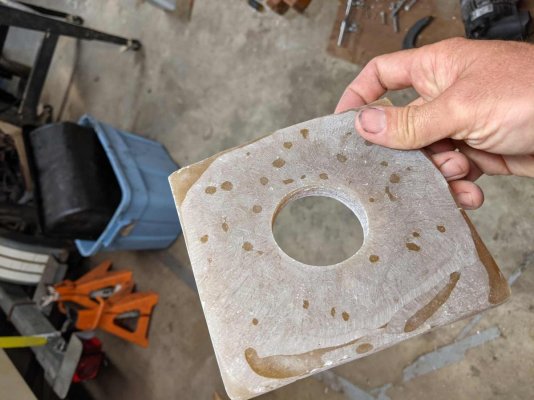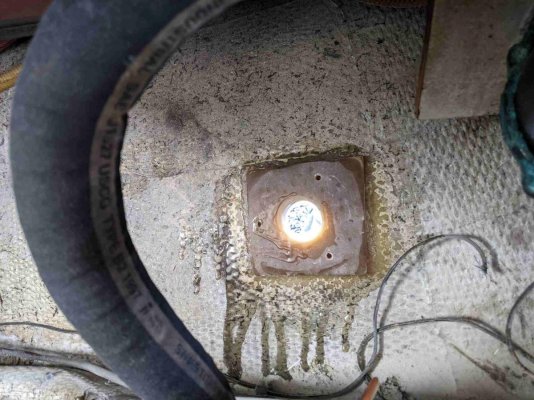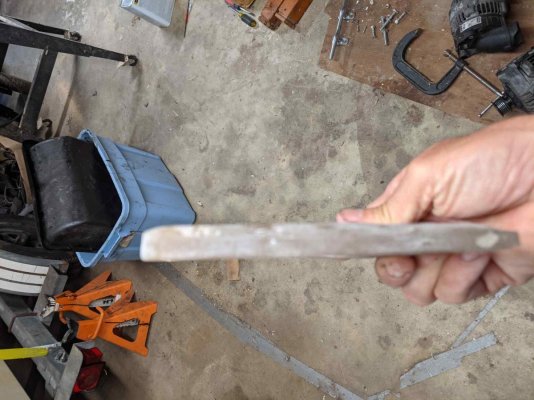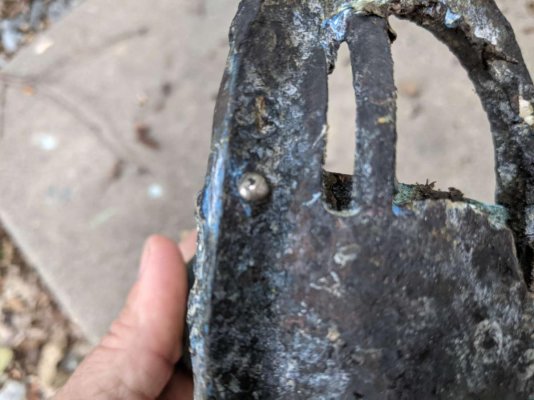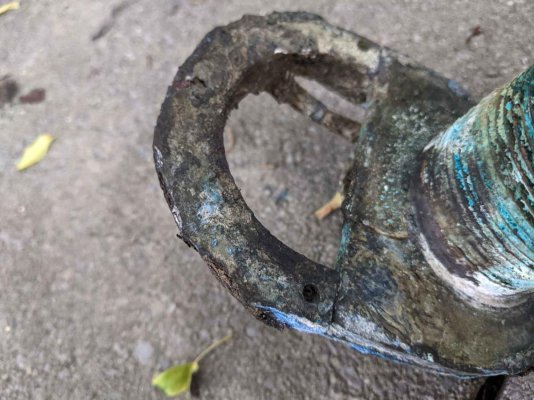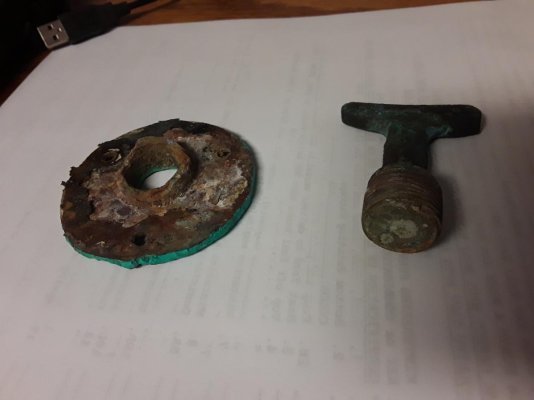Gdavid
Guru
I'm going to track my first haul out in this thread for the purpose of comparing notes with others and just tracking my progress. When I was purchasing the boat, it was already in the water so the surveyor did the in water inspection, we hauled out and hung it in the slings for the out of water survey and relaunched for the sea trial. I would have preferred to reverse the order of sea trail and haul out and then had the boat blocked up so I could repaint the bottom, but the yard was still full of boats coming out of winter storage.
The bottom paint on the boat was probably about 1 year old and holding up pretty well at the time of survey but pressure washing for the survey blasted off a lot of small chips, particularly around the waterline so the boat was starting to get fouled pretty quickly. I really don't want to lose much of our peak boating season out of the water but I also don't want the bottom to turn into a real mess. There are some small blisters, nothing concerning but I do plan on soda blasting down to bare gel in the fall and letting it dry out thoroughly over the winter and barrier coating in the spring. For now I just need a coat of paint to get me through to the fall. I'm using the blue water copper shield 45 ablative.
The engine cooling thru hull needs to be replaced. It has external grating which has broken up which probably means the whole fitting is weakened so it will be replaced. I have an internal strainer and I don't feel the need to run both external and and internal screening so I'm going with a regular mushroom thru hull so I can clear it with a dowel rod if it gets fouled with growth. The easiest way I have found is to install a bronze T fitting above the ball valve and have nipple and hose headed to the strainer come out the side then put a threaded plug at the top of the T fitting in line with the valve and thru hull, that way I can close the valve, remove the plug, insert a rod/stick/ whatever, quickly open the valve all the way and then run the rod clear through the valve and out the bottom of the boat to ensure a clear path. As slow as my boat is, I don't think a scoop is needed.
I have a couple nylon (not marelon) thru hulls above the water line that I need to replace as well. The garboard drain is definitely getting replaced too.
I would like to finish up my new anchor pulpit project and get that mounted while I'm in the boat yard and can make a mess without disturbing my dock neighbors but I've been a bit slow on the job and the glass work is no where near done.
While it doesn't need to happen on land, I'll also install the new combination oil cooler and transmission cooler that just arrived from Mr Cool. The transmission side of the stock cooler has been abandoned and replaced by a standalone transmission cooler but the engine oil is still being cooled by the original. It seems like a good time to refresh the whole system and hopefully avoid the oil side of the cooler failing, it should declutter the engine just a little. The transmission lines appear to have been shortened when it was retrofitted so I'll have to replace at least one of them with a longer line to reach the stock position.
I have some pretty bad cracks through the gelcoat on the starboard side where someone must have struck a dock or piling pretty hard, there must be damage to the substrate fiberglass for the crack to be so large, I'm not sure if I will bet to this project or not. My survey who also does glass repair (or used to) recommended just covering it up with shrink wrap tape and waiting till the off season. I'll probably go this route.
I've done much of the yard work on my Father's boats for years so this feels familiar but different at the same time. When you are ultimately responsible for the decisions and cutting the checks, it just changes things. It is nice to have him as a sounding board as well as this forum to consult on priorities for projects and especially when to say enough and just use the damn boat.
The bottom paint on the boat was probably about 1 year old and holding up pretty well at the time of survey but pressure washing for the survey blasted off a lot of small chips, particularly around the waterline so the boat was starting to get fouled pretty quickly. I really don't want to lose much of our peak boating season out of the water but I also don't want the bottom to turn into a real mess. There are some small blisters, nothing concerning but I do plan on soda blasting down to bare gel in the fall and letting it dry out thoroughly over the winter and barrier coating in the spring. For now I just need a coat of paint to get me through to the fall. I'm using the blue water copper shield 45 ablative.
The engine cooling thru hull needs to be replaced. It has external grating which has broken up which probably means the whole fitting is weakened so it will be replaced. I have an internal strainer and I don't feel the need to run both external and and internal screening so I'm going with a regular mushroom thru hull so I can clear it with a dowel rod if it gets fouled with growth. The easiest way I have found is to install a bronze T fitting above the ball valve and have nipple and hose headed to the strainer come out the side then put a threaded plug at the top of the T fitting in line with the valve and thru hull, that way I can close the valve, remove the plug, insert a rod/stick/ whatever, quickly open the valve all the way and then run the rod clear through the valve and out the bottom of the boat to ensure a clear path. As slow as my boat is, I don't think a scoop is needed.
I have a couple nylon (not marelon) thru hulls above the water line that I need to replace as well. The garboard drain is definitely getting replaced too.
I would like to finish up my new anchor pulpit project and get that mounted while I'm in the boat yard and can make a mess without disturbing my dock neighbors but I've been a bit slow on the job and the glass work is no where near done.
While it doesn't need to happen on land, I'll also install the new combination oil cooler and transmission cooler that just arrived from Mr Cool. The transmission side of the stock cooler has been abandoned and replaced by a standalone transmission cooler but the engine oil is still being cooled by the original. It seems like a good time to refresh the whole system and hopefully avoid the oil side of the cooler failing, it should declutter the engine just a little. The transmission lines appear to have been shortened when it was retrofitted so I'll have to replace at least one of them with a longer line to reach the stock position.
I have some pretty bad cracks through the gelcoat on the starboard side where someone must have struck a dock or piling pretty hard, there must be damage to the substrate fiberglass for the crack to be so large, I'm not sure if I will bet to this project or not. My survey who also does glass repair (or used to) recommended just covering it up with shrink wrap tape and waiting till the off season. I'll probably go this route.
I've done much of the yard work on my Father's boats for years so this feels familiar but different at the same time. When you are ultimately responsible for the decisions and cutting the checks, it just changes things. It is nice to have him as a sounding board as well as this forum to consult on priorities for projects and especially when to say enough and just use the damn boat.
Last edited:




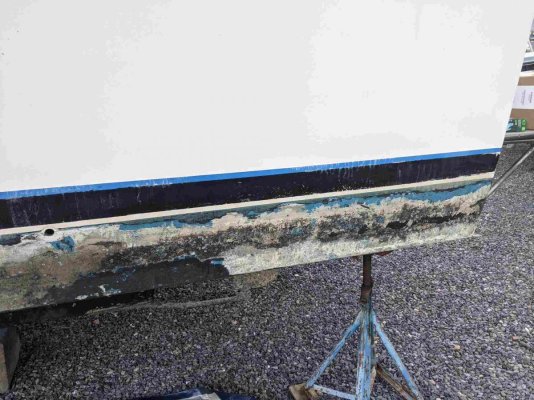
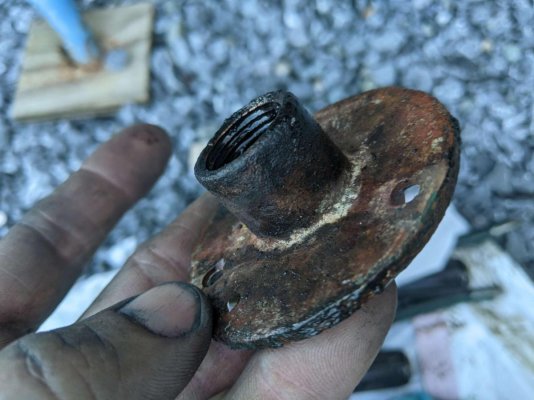
 How lazy can they get?!
How lazy can they get?!